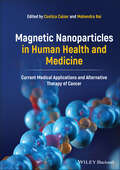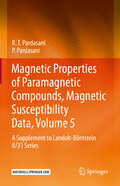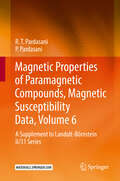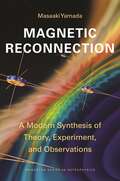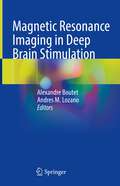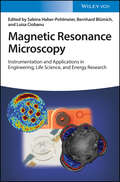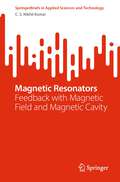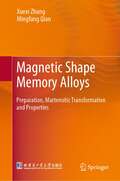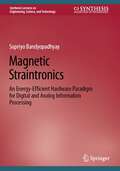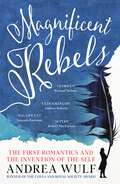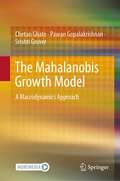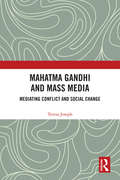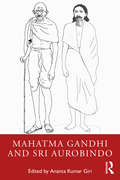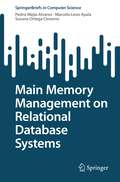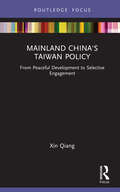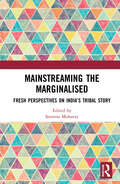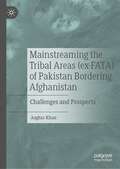- Table View
- List View
Magnetic Nanoparticles in Human Health and Medicine: Current Medical Applications and Alternative Therapy of Cancer
by Costica Caizer Mahendra RaiExplores the application of magnetic nanoparticles in drug delivery, magnetic resonance imaging, and alternative cancer therapy Magnetic Nanoparticles in Human Health and Medicine addresses recent progress in improving diagnosis by magnetic resonance imaging (MRI) and using non-invasive and non-toxic magnetic nanoparticles for targeted drug delivery. Focusing on cancer diagnosis and therapy, the book covers both fundamental principles and advanced theoretical and experimental research on the magnetic properties, biocompatibilization, biofunctionalization, and application of magnetic nanoparticles in nanobiotechnology and nanomedicine. Chapters written by a panel of international specialists in the field of magnetic nanoparticles and their applications in biomedicine cover magnetic hyperthermia (MHT), MRI contrast agents, biomedical imaging, modeling and simulation, nanobiotechnology, toxicity issues, and more. Readers are provided with accurate information on the use of magnetic nanoparticles in diagnosis, drug delivery, and therapeutics—featuring discussion of current problems, proposed solutions, and future research directions. Topics include magnetic nanoparticles with antioxidant activity, iron oxide nanoparticles in nanomedicine, superparamagnetic hyperthermia in clinical trials, and simulating the physics of magnetic particle heating for biomedical applications. This comprehensive volume: Covers both general research on magnetic nanoparticles in medicine and specific applications in cancer therapeutics Discusses the use of magnetic nanoparticles in alternative cancer therapy by magnetic and superparamagnetic hyperthermia Explores targeted medication delivery using magnetic nanoparticles as a future replacement of conventional techniques Reviews the use of MRI with magnetic nanoparticles to increase the diagnostic accuracy of medical imaging Magnetic Nanoparticles in Human Health and Medicine is a valuable resource for researchers in the fields of nanomagnetism, nanomaterials, magnetic nanoparticles, nanoengineering, biopharmaceuticals nanobiotechnologies, nanomedicine,and biopharmaceuticals, particularly those focused on cancer diagnosis and therapeutics.
Magnetic Nanoparticles in Human Health and Medicine: Current Medical Applications and Alternative Therapy of Cancer
by Costica Caizer Mahendra RaiExplores the application of magnetic nanoparticles in drug delivery, magnetic resonance imaging, and alternative cancer therapy Magnetic Nanoparticles in Human Health and Medicine addresses recent progress in improving diagnosis by magnetic resonance imaging (MRI) and using non-invasive and non-toxic magnetic nanoparticles for targeted drug delivery. Focusing on cancer diagnosis and therapy, the book covers both fundamental principles and advanced theoretical and experimental research on the magnetic properties, biocompatibilization, biofunctionalization, and application of magnetic nanoparticles in nanobiotechnology and nanomedicine. Chapters written by a panel of international specialists in the field of magnetic nanoparticles and their applications in biomedicine cover magnetic hyperthermia (MHT), MRI contrast agents, biomedical imaging, modeling and simulation, nanobiotechnology, toxicity issues, and more. Readers are provided with accurate information on the use of magnetic nanoparticles in diagnosis, drug delivery, and therapeutics—featuring discussion of current problems, proposed solutions, and future research directions. Topics include magnetic nanoparticles with antioxidant activity, iron oxide nanoparticles in nanomedicine, superparamagnetic hyperthermia in clinical trials, and simulating the physics of magnetic particle heating for biomedical applications. This comprehensive volume: Covers both general research on magnetic nanoparticles in medicine and specific applications in cancer therapeutics Discusses the use of magnetic nanoparticles in alternative cancer therapy by magnetic and superparamagnetic hyperthermia Explores targeted medication delivery using magnetic nanoparticles as a future replacement of conventional techniques Reviews the use of MRI with magnetic nanoparticles to increase the diagnostic accuracy of medical imaging Magnetic Nanoparticles in Human Health and Medicine is a valuable resource for researchers in the fields of nanomagnetism, nanomaterials, magnetic nanoparticles, nanoengineering, biopharmaceuticals nanobiotechnologies, nanomedicine,and biopharmaceuticals, particularly those focused on cancer diagnosis and therapeutics.
Magnetic Properties of Metals: Magnetic and Electric Properties of Magnetic Metallic Multilayers
by Yoshiyuki Kawazoe Ryunosuke NoteMagnetic Properties of Paramagnetic Compounds, Magnetic Susceptibility Data, Volume 5: A Supplement to Landolt-Börnstein II/31 Series
by P. Pardasani R.T. PardasaniWith the objective to collate the enormous amount of information on magnetic susceptibility parameters of a very large number of a variety of skeletons and present it in a form that can readily be retrieved and used, a new pattern is being introduced with the present volume keeping in view that now a majority of research groups look at the scientific data electronically.In this volume, magnetic properties of complexes of La, Ti, V, Cr, Mo, Mn, Re, Fe, Ru, Os, Co, Rh, Ni, Pd, Pt, Cu, Au, Ce, Pr, Nd, Sm, Gd, Tb, Ho, Yb are described.All the magnetic properties of each individual substance are listed as a single document which is self-explainable and allowing search in respect of substance name, synonyms, common vocabulary, and even structure.
Magnetic Properties of Paramagnetic Compounds, Magnetic Susceptibility Data, Volume 6: A Supplement to Landolt-Börnstein II/31 Series
by R.T. Pardasani P. PardasaniWith the objective to collate the enormous amount of information on magnetic susceptibility parameters of a very large number of a variety of skeletons and present it in a form that can readily be retrieved and used, a new pattern is being introduced with the present volume keeping in view that now a majority of research groups look at the scientific data electronically.In this volume, magnetic properties of complexes of La, Ti, Zr, V, Cr, W, Mn, Fe, Ru, Os, Co, Ni, Pd, Pt, Cu, Ag, Ce, Pr, Nd, Sm, Ho are described.All the magnetic properties of each individual substance are listed as a single document which is self-explainable and allowing search in respect of substance name, synonyms, common vocabulary, and even structure.
Magnetic Reconnection: A Modern Synthesis of Theory, Experiment, and Observations (Princeton Series in Astrophysics #61)
by Masaaki YamadaThe essential introduction to magnetic reconnection—written by a leading pioneer of the fieldPlasmas comprise more than 99 percent of the visible universe; and, wherever plasmas are, magnetic reconnection occurs. In this common yet incompletely understood physical process, oppositely directed magnetic fields in a plasma meet, break, and then reconnect, converting the huge amounts of energy stored in magnetic fields into kinetic and thermal energy. In Magnetic Reconnection, Masaaki Yamada offers an illuminating synthesis of modern research and advances on this important topic. Magnetic reconnection produces such phenomena as solar flares and the northern lights, and occurs in nuclear fusion devices. A better understanding of this crucial cosmic activity is essential to comprehending the universe and varied technological applications, such as satellite communications.Most of our knowledge of magnetic reconnection comes from theoretical and computational models and laboratory experiments, but space missions launched in recent years have added up-close observation and measurements to researchers’ tools. Describing the fundamental physics of magnetic reconnection, Yamada links the theory with the latest results from laboratory experiments and space-based observations, including the Magnetic Reconnection Experiment (MRX) and the Magnetospheric Multiscale (MMS) Mission. He concludes by considering outstanding problems and laying out a road map for future research.Aimed at advanced graduate students and researchers in plasma astrophysics, solar physics, and space physics, Magnetic Reconnection provides cutting-edge information on a vital area of scientific investigation.
Magnetic Resonance Imaging in Deep Brain Stimulation
by Alexandre Boutet Andres M. LozanoThis book describes the roles magnetic resonance imaging (MRI) can play in deep brain stimulation (DBS). DBS therapeutically modulates aberrant neural circuits implicated in a broad range of neurological disorders. Following surgical insertion, an electrode placed into the desired brain target generates constant electricity, analogous to a cardiac pacemaker. Most commonly employed in movement disorders such as Parkinson’s disease, dystonia, and tremor, DBS is also being investigated for use in psychiatric and cognitive disorders, including depression and Alzheimer’s disease. It is estimated that more than 230,000 patients have undergone DBS surgery worldwide. Imaging techniques, specifically MRI, have played key roles in the preoperative and postoperative aspects of DBS. This book focuses on the established as well as the innovative roles of MRI in DBS. MRI and DBS are first introduced from an historical perspective and a review of the clinical aspects of DBS is performed. Then, the preoperative and postoperative applications of MRI in DBS are covered. The crucial aspect of MRI safety in these patients is also discussed. Finally, possible upcoming MRI applications for patients with DBS are discussed in a future directions chapter. Chapters are written by experts from the University of Toronto, a world leader in the field of DBS, alongside international co-authors to ensure a thorough review of the topics. This is an ideal guide for both clinicians (neurosurgeons, neurologists, psychiatrists, and neuroradiologists) and researchers as well as trainees interested in neuroimaging for DBS.
Magnetic Resonance Microscopy: Instrumentation and Applications in Engineering, Life Science, and Energy Research
by Luisa Ciobanu Sabine Haber-Pohlmeier Bernhard BlumichMagnetic Resonance Microscopy Explore the interdisciplinary applications of magnetic resonance microscopy in this one-of-a-kind resource In Magnetic Resonance Microscopy: Instrumentation and Applications in Engineering, Life Science and Energy Research, a team of distinguished researchers delivers a comprehensive exploration of the use of magnetic resonance microscopy (MRM) and similar techniques in an interdisciplinary milieux. Opening with a section on hardware and methodology, the book moves on to consider developments in the field of mobile nuclear magnetic resonance. Essential processes, including filtration, multi-phase flow and transport, and a wide range of systems – from biomarkers via single cells to plants and biofilms – are discussed next. After a fulsome treatment of MRM in the field of energy research, the editors conclude the book with a chapter extoling the virtues of a holistic treatment of theory and application in MRM. Magnetic Resonance Microscopy: Instrumentation and Applications in Engineering, Life Science and Energy Research also includes: A thorough introduction to recent developments in magnetic resonance microscopy hardware and methods, including ceramic coils for MR microscopy Comprehensive explorations of applications in chemical engineering, including ultra-fast MR techniques to image multi-phase flow in pipes and reactors Practical discussions of applications in the life sciences, including MRI of single cells labelled with super paramagnetic iron oxide nanoparticles In-depth examinations of new applications in energy research, including spectroscopic imaging of devices for electrochemical storage Perfect for practicing scientists from all fields, Magnetic Resonance Microscopy: Instrumentation and Applications in Engineering, Life Science and Energy Research is an ideal resource for anyone seeking a one-stop guide to magnetic resonance microscopy for engineers, life scientists, and energy researchers.
Magnetic Resonance Microscopy: Instrumentation and Applications in Engineering, Life Science, and Energy Research
by Luisa Ciobanu Bernhard Blumich Sabina Haber-PohlmeierMagnetic Resonance Microscopy Explore the interdisciplinary applications of magnetic resonance microscopy in this one-of-a-kind resource In Magnetic Resonance Microscopy: Instrumentation and Applications in Engineering, Life Science and Energy Research, a team of distinguished researchers delivers a comprehensive exploration of the use of magnetic resonance microscopy (MRM) and similar techniques in an interdisciplinary milieux. Opening with a section on hardware and methodology, the book moves on to consider developments in the field of mobile nuclear magnetic resonance. Essential processes, including filtration, multi-phase flow and transport, and a wide range of systems – from biomarkers via single cells to plants and biofilms – are discussed next. After a fulsome treatment of MRM in the field of energy research, the editors conclude the book with a chapter extoling the virtues of a holistic treatment of theory and application in MRM. Magnetic Resonance Microscopy: Instrumentation and Applications in Engineering, Life Science and Energy Research also includes: A thorough introduction to recent developments in magnetic resonance microscopy hardware and methods, including ceramic coils for MR microscopy Comprehensive explorations of applications in chemical engineering, including ultra-fast MR techniques to image multi-phase flow in pipes and reactors Practical discussions of applications in the life sciences, including MRI of single cells labelled with super paramagnetic iron oxide nanoparticles In-depth examinations of new applications in energy research, including spectroscopic imaging of devices for electrochemical storage Perfect for practicing scientists from all fields, Magnetic Resonance Microscopy: Instrumentation and Applications in Engineering, Life Science and Energy Research is an ideal resource for anyone seeking a one-stop guide to magnetic resonance microscopy for engineers, life scientists, and energy researchers.
Magnetic Resonators: Feedback with Magnetic Field and Magnetic Cavity (SpringerBriefs in Applied Sciences and Technology)
by C. S. Nikhil KumarThe phase-locking of multiple spin-torque nano oscillators(STNOs) is considered the primary vehicle to achieve sufficient signal quality for applications. This book highlights the resonator's design and its need for feedback for phase locking of STNOs. STNOs can act as sources of tunable microwaves after being phase-locked together. External feedback from a coplanar waveguide placed above an STNO helps ensures coherent single domain oscillations. STNOs placed within magnonic crystal cavities also demonstrate coherent oscillations. Arrays of such cavities provide a route to scale power levels from such nano-oscillators. The book presents numerical and micromagnetics to validate the design.
Magnetic Shape Memory Alloys: Preparation, Martensitic Transformation and Properties
by Xuexi Zhang Mingfang QianThis book systematically describes the fundamentals of Magnetic shape memory alloys (MSMAs), with an emphasis on low-dimensional structures such as foams, microwires and micro-particles. The respective chapters address basic concepts and theories, the fabrication of various architectures, microstructure tailoring, property optimization and cutting-edge applications. Taken together, they provide a clear understanding of the correlation between processing and the microstructural properties of MSMAs, which are illustrated in over two hundred figures and schematics. Given its scope and format, the book offers a valuable resource for a broad readership in various fields of materials science and engineering, especially for researchers, students and engineers.
Magnetic Straintronics: An Energy-Efficient Hardware Paradigm for Digital and Analog Information Processing (Synthesis Lectures on Engineering, Science, and Technology)
by Supriyo BandyopadhyayThis book covers the new field of straintronics, using strain switched nanomagnets for extremely energy-efficient computing, information processing, communication, and signal generation. Based on well-established CMOS technology, traditional electronics have two significant shortcomings: excessive energy dissipation and volatility, which is the inability to retain information after power has been switched off. Straintronics is more energy-efficient and non-volatile (but also more error-prone), allowing it to eclipse traditional electronics in niche areas that are increasingly attracting attention, such as image processing and probabilistic computing, computer vision, machine learning, neuromorphic networks, probabilistic computing, and belief networks. Magnetic Straintronics: An Energy-Efficient Hardware Paradigm for Digital and Analog Information Processing introduces straintronics and the technology's myriad applications for researchers, engineers, and scientists in electrical engineering, physics, and computer engineering.
Magnificent Rebels: The First Romantics and the Invention of the Self
by Andrea Wulf'Elegantly written, deeply researched and totally gripping' SIMON SEBAG MONTEFIOREIn the 1790s an extraordinary group of friends changed the world. Disappointed by the French Revolution's rapid collapse into tyranny, what they wanted was nothing less than a revolution of the mind. The rulers of Europe had ordered their peoples how to think and act for too long. Based in the small German town of Jena, through poetry, drama, philosophy and science, they transformed the way we think about ourselves and the world around us. They were the first Romantics.Their way of understanding the world still frames our lives and being.We're still empowered by their daring leap into the self. We still think with their minds, see with their imagination and feel with their emotions. We also still walk the same tightrope between meaningful self-fulfilment and destructive narcissism, between the rights of the individual and our role as a member of our community and our responsibilities towards future generations who will inhabit this planet. This extraordinary group of friends changed our world. It is impossible to imagine our lives, thoughts and understanding without the foundation of their ground-breaking ideas.
The Mahalanobis Growth Model: A Macrodynamics Approach
by Chetan Ghate Pawan Gopalakrishnan Srishti GroverThis book provides an analytical and computational approach to solving and simulating the Mahalanobis model and the papers surrounding it. The book comes up, perhaps for the first time, with a holistic examination of an important growth model that emerged out of India in the 1950s. It contains detailed derivations of the Mahalanobis model and the several critiques and extensions surrounding it with an organized synthesis of the main results. Computationally, the book simulates the model and its many variants, thus making it accessible to a wider audience. Advanced undergraduates and beginning graduate students in the fields of Economics, Mathematics, and Statistics will gain immensely from understanding both the mathematical aspects as well as the computational aspects of the Mahalanobis model. In the absence of a single 'go-to' source on all aspects of the model -- analytical and computational -- this book is a definitive volume on the Mahalanobis model that has all the derivations of all the papers surrounding the model, its dissents and critiques, and extensions as in the wage goods model suggested by Vakil and Brahmananda.
Mahatma Gandhi and Mass Media: Mediating Conflict and Social Change
by Teresa JosephThis book explores Gandhi’s engagement with print news media. It examines how Gandhi, the man and his message, negotiated with the sociopolitical circumstances of his milieu and the methods of communication that he adopted towards this end. It analyses the role that he played in building up alternative modes of communication in South Africa and India. This volume elucidates his interactions with the colonial communication order and his contestations of the same through various methods that included setting up new journals and newspapers and taking on the role of writer, journalist, editor, and publisher. It unveils Gandhi’s engagement with mass media and print journalism, particularly concerning issues of conflict and conflict resolution, as well as social transformation right from his days in London to the last days of his life. A significant contribution to scholarship on Mahatma Gandhi, this volume will be of great interest to scholars of politics, media and cultural studies, history, and South Asian studies.
Mahatma Gandhi and Mass Media: Mediating Conflict and Social Change
by Teresa JosephThis book explores Gandhi’s engagement with print news media. It examines how Gandhi, the man and his message, negotiated with the sociopolitical circumstances of his milieu and the methods of communication that he adopted towards this end. It analyses the role that he played in building up alternative modes of communication in South Africa and India. This volume elucidates his interactions with the colonial communication order and his contestations of the same through various methods that included setting up new journals and newspapers and taking on the role of writer, journalist, editor, and publisher. It unveils Gandhi’s engagement with mass media and print journalism, particularly concerning issues of conflict and conflict resolution, as well as social transformation right from his days in London to the last days of his life. A significant contribution to scholarship on Mahatma Gandhi, this volume will be of great interest to scholars of politics, media and cultural studies, history, and South Asian studies.
Mahatma Gandhi and Sri Aurobindo
by Giri KumarThis book presents the first systematic critical exploration of the philosophical and political thoughts of Mahatma Gandhi and Sri Aurobindo, both pioneers of modern Indian thought. Bringing together experts from across the world, the volume examines the thoughts, ideas, actions, lives and experiments of Mahatma Gandhi and Sri Aurobindo on themes such as radical politics and human agency; ideals of human unity; social practices and citizenship; horizons of sustainable development and climate change; inclusive freedom; conceptions of swaraj; interpretations of texts; Sri Aurobindo’s views on Indian culture; integral yoga; transformative leadership; Anthropocene and alternative planetary futures. The book discusses the contemporary legacies and works of the two influential thinkers. It offers insights into historical, philosophical, theoretical, literary and sociological questions that establish the need for transdisciplinary dialogues and the relevance of their visions towards future evolution. This book will be useful to scholars and researchers of political science, Indian political thought, comparative politics, philosophy, Indian philosophy, sociology, anthropology, modern Indian history, peace studies, cultural studies, religious studies and South Asian studies.
Mahatma Gandhi and Sri Aurobindo
by Ananta Kumar GiriThis book presents the first systematic critical exploration of the philosophical and political thoughts of Mahatma Gandhi and Sri Aurobindo, both pioneers of modern Indian thought. Bringing together experts from across the world, the volume examines the thoughts, ideas, actions, lives and experiments of Mahatma Gandhi and Sri Aurobindo on themes such as radical politics and human agency; ideals of human unity; social practices and citizenship; horizons of sustainable development and climate change; inclusive freedom; conceptions of swaraj; interpretations of texts; Sri Aurobindo’s views on Indian culture; integral yoga; transformative leadership; Anthropocene and alternative planetary futures. The book discusses the contemporary legacies and works of the two influential thinkers. It offers insights into historical, philosophical, theoretical, literary and sociological questions that establish the need for transdisciplinary dialogues and the relevance of their visions towards future evolution. This book will be useful to scholars and researchers of political science, Indian political thought, comparative politics, philosophy, Indian philosophy, sociology, anthropology, modern Indian history, peace studies, cultural studies, religious studies and South Asian studies.
The Maiden Voyage of Petrus van Stijn: A Novel
by Michael Charles TobiasPetrus van Stijn’s world is besieged by two prime engines of destruction: massive geomagnetic storms caused by unprecedented solar storms – protracted coronal mass ejections (CME), and climate change wreaking unprecedented, but predictable collapse of the Antarctic ice shelves. Petrus has other problems to contend with, like surviving on a floating archipelago of ice, and then walking 2200 kilometers through a post-Apocalyptic world. At the same time, Petrus will discover something of a true social and biological paradise. Herein lies the paradox of a world where one species – ours – is facing extinction, while others – many genetically re-engineered – are enjoying a biodiversity renaissance.With a Foreword by William Shatner, this provocative, lyrical, deeply philosophical work of fiction explores the ethical limits of science and technology, and the future of all life on earth.
Main Memory Management on Relational Database Systems (SpringerBriefs in Computer Science)
by Pedro Mejia Alvarez Marcelo Leon Ayala Susana Ortega CisnerosThis book provides basic knowledge about main memory management in relational databases as it is needed to support large-scale applications processed completely in memory. In business operations, real-time predictability and high speed is a must. Hence every opportunity must be exploited to improve performance, including reducing dependency on the hard disk, adding more memory to make more data resident in the memory, and even deploying an in-memory system where all data can be kept in memory. The book provides one chapter for each of the main related topics, i.e. the memory system, memory management, virtual memory, and databases and their memory systems, and it is complemented by a short survey of six commercial systems: TimesTen, MySQL, VoltDB, Hekaton, HyPer/ScyPer, and SAP HANA.
Mainland China's Taiwan Policy: From Peaceful Development to Selective Engagement (Routledge Focus on Public Governance in Asia)
by Xin QiangThe Taiwan issue has always been a core national interest of mainland China, which has steadfastly vowed to fulfill national reunification. This book provides a comprehensive and updated explanation of the strategic motivations, behavioral logic, and policymaking rationale of Beijing’s Taiwan policy. It will aid readers in predicting the future development of cross-Strait relations, reducing the risk of strategic miscalculations, and defusing potential geostrategic perils. The book analyzes Beijing’s changing policy toward Taiwan during the Kuomintang and Democratic Progressive Party administrations. It explains the key driving forces for Beijing’s Taiwan policy in these different periods, which have displayed fundamental shifts from confrontation to cooperation and then back to confrontation. The book also delves into how the rising strategic rivalry between China and the US may influence Beijing’s Taiwan policy and the prospect of cross-Strait relations in the near future. The book will be a useful reference to deepen intellectual understanding of Beijing’s broader security and diplomatic policies. It will also appeal to government policymakers who have a keen and vested interest in peace and security in the West Pacific.
Mainland China's Taiwan Policy: From Peaceful Development to Selective Engagement (Routledge Focus on Public Governance in Asia)
by Xin QiangThe Taiwan issue has always been a core national interest of mainland China, which has steadfastly vowed to fulfill national reunification. This book provides a comprehensive and updated explanation of the strategic motivations, behavioral logic, and policymaking rationale of Beijing’s Taiwan policy. It will aid readers in predicting the future development of cross-Strait relations, reducing the risk of strategic miscalculations, and defusing potential geostrategic perils. The book analyzes Beijing’s changing policy toward Taiwan during the Kuomintang and Democratic Progressive Party administrations. It explains the key driving forces for Beijing’s Taiwan policy in these different periods, which have displayed fundamental shifts from confrontation to cooperation and then back to confrontation. The book also delves into how the rising strategic rivalry between China and the US may influence Beijing’s Taiwan policy and the prospect of cross-Strait relations in the near future. The book will be a useful reference to deepen intellectual understanding of Beijing’s broader security and diplomatic policies. It will also appeal to government policymakers who have a keen and vested interest in peace and security in the West Pacific.
Mainstreaming the Marginalised: Fresh Perspectives on India’s Tribal Story
by Seemita MohantyThis book offers a comprehensive view of the relationship between the Indian tribes and the mainstream. It covers key topics such as health, education, development, livelihood, disability, and culture, and presents new insights by focusing on the perspective of the 21st-century tribal youth of the country. The volume explores inclusive education for scheduled tribes children; mainstreaming tribal children; mental health and superstition; ageing and morbidity and psychological distress among elderly tribal population; empowerment via handicraft; livelihoods via non-timber forest produce; the Forest Right Act; the tribal sub-plan approach; tribal cuisine and issues of food; identity; myths and feminism. The book combines fresh research viewpoints with ideas on implementable solutions that would facilitate a more inclusive development for one of the most marginalized communities while highlighting critical issues and concerns. An important intervention, this book will be useful to scholars and researchers of tribal studies, sociology, rural sociology, development studies, social anthropology, political sociology, politics, ethnic studies, sociolinguistics, education, and public policy and administration.
Mainstreaming the Marginalised: Fresh Perspectives on India’s Tribal Story
by Seemita MohantyThis book offers a comprehensive view of the relationship between the Indian tribes and the mainstream. It covers key topics such as health, education, development, livelihood, disability, and culture, and presents new insights by focusing on the perspective of the 21st-century tribal youth of the country. The volume explores inclusive education for scheduled tribes children; mainstreaming tribal children; mental health and superstition; ageing and morbidity and psychological distress among elderly tribal population; empowerment via handicraft; livelihoods via non-timber forest produce; the Forest Right Act; the tribal sub-plan approach; tribal cuisine and issues of food; identity; myths and feminism. The book combines fresh research viewpoints with ideas on implementable solutions that would facilitate a more inclusive development for one of the most marginalized communities while highlighting critical issues and concerns. An important intervention, this book will be useful to scholars and researchers of tribal studies, sociology, rural sociology, development studies, social anthropology, political sociology, politics, ethnic studies, sociolinguistics, education, and public policy and administration.
Mainstreaming the Tribal Areas (ex-FATA) of Pakistan Bordering Afghanistan: Challenges and Prospects
by Asghar KhanThe book addresses why the Pakistani state is facing persistent challenges in extending and consolidating its governance (authority) throughout its territories, especially in the former Federally Administered Tribal Areas (ex-FATA)? Even after the de jure merger, the question still remains valid that how Pakistani state could establish its governance in these tribal areas? Through multi-dimensional approaches and multi-pronged analysis of state-centric (top-down), society-centric (bottom-up) and state-in-society (mixed-horizontal) approaches, the book explains factors and dimensions that pose challenges to Pakistani state governance in ex-FATA. The main hypothesis is that societies, where state governance is absent, turn to informal governance and create informal institutions as a substitute for the weak central state governance thereby challenging the domination and control/authority of the state. The book presents policy recommendations for bringing these tribal areas into the mainstream governance system of Pakistan.
